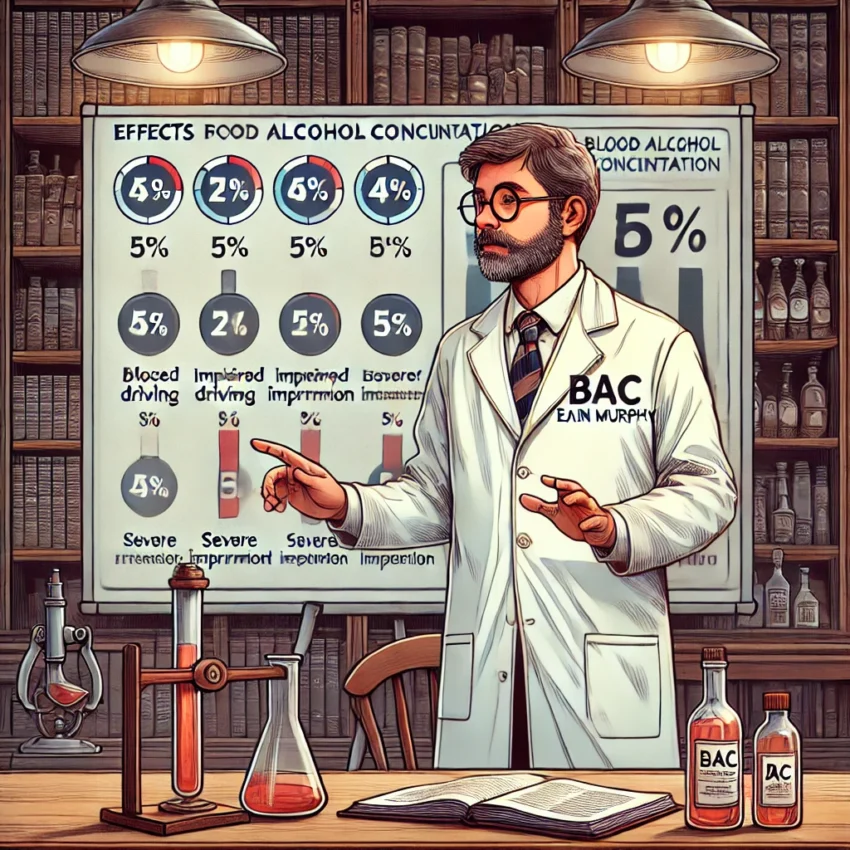Before diving into what Eain Murphy has to say about BAC, let’s first understand the basics of BAC itself. BAC, or Blood Alcohol Concentration, measures the amount of alcohol present in a person’s bloodstream. It’s a crucial indicator used for medical, legal, and safety purposes, often associated with assessing levels of intoxication.
What is BAC?
BAC is represented as a percentage. For example, a BAC of 0.08% means that there is 0.08 grams of alcohol per 100 milliliters of blood. This measure is widely used across various sectors, from healthcare to law enforcement, and it plays a significant role in regulations regarding alcohol consumption, driving, and workplace safety.
Who is Eain Murphy?
Eain Murphy is recognized for his insightful contributions to the field of substance analysis and public health. Known for his expertise in toxicology and chemical measurements, Murphy often addresses the effects and implications of substances like alcohol, providing essential insights into the science of intoxication.
Murphy has published several pieces on the science of BAC, helping readers better understand how the body processes alcohol and the impact of various BAC levels on behavior, health, and decision-making.
Eain Murphy’s Perspective on BAC Levels
Eain Murphy’s approach to BAC analysis provides a clear breakdown of how alcohol affects different BAC levels and why these increments matter for understanding intoxication. Let’s explore Murphy’s key points on BAC, as he describes it.
1. Low BAC Levels (0.01% – 0.05%)
Murphy notes that at low BAC levels, effects are often mild and may include a slight feeling of relaxation or warmth. Individuals may feel more socially confident, but their physical and mental abilities remain largely unaffected.
2. Moderate BAC Levels (0.06% – 0.15%)
At this stage, Murphy explains that BAC levels between 0.06% and 0.15% start to noticeably affect motor skills, decision-making, and reaction time. Eain Murphy stresses that while some may still feel “in control,” this level significantly impairs driving abilities and increases the risk of accidents.
3. High BAC Levels (0.16% and Above)
When BAC levels exceed 0.16%, Murphy points out that severe impairment sets in. Individuals might experience blurred vision, slurred speech, and loss of coordination. According to Murphy, BAC at this level can result in poor judgment and, in extreme cases, blackouts or alcohol poisoning.
4. Lethal BAC Levels
Murphy also highlights the risks associated with BAC levels reaching 0.30% and higher. At these levels, alcohol affects the central nervous system, potentially leading to loss of consciousness, respiratory failure, or even death. Eain Murphy’s work emphasizes the importance of understanding BAC to avoid such critical health risks.
Factors Affecting BAC, According to Murphy
Eain Murphy emphasizes that several factors contribute to BAC levels and their effects:
- Body Weight and Composition: Individuals with more body mass generally have a lower BAC compared to those with less body mass, assuming equal alcohol consumption.
- Gender: Murphy highlights that due to biological differences, women often reach higher BAC levels than men after consuming the same amount of alcohol.
- Food Intake: Eating before or during alcohol consumption slows the absorption of alcohol, leading to a slower increase in BAC.
- Metabolism and Health Conditions: Health conditions, medication, and individual metabolic rates also impact how quickly BAC levels rise and fall.
Murphy advises that awareness of these factors can help individuals make more informed decisions regarding alcohol consumption.
The Legal and Practical Importance of BAC in Society
One of Murphy’s main messages about BAC is its importance in regulatory and safety practices. For instance, legal BAC limits help prevent impaired driving, reducing accidents and promoting road safety. Murphy also highlights the practical role of BAC in workplace safety, particularly in jobs requiring high levels of attention and coordination.
Eain Murphy’s Recommendations for BAC Management
Murphy’s work includes several recommendations to help individuals manage their BAC levels responsibly:
- Pacing Alcohol Consumption: Murphy advises drinking slowly and alternating alcoholic beverages with water or non-alcoholic drinks.
- Planning Safe Transportation: He suggests arranging transportation alternatives, like ride-sharing, if one plans to drink, to avoid the risks associated with driving under the influence.
- Monitoring BAC with Tools: For those who regularly consume alcohol, Murphy suggests using tools like personal breathalyzers to monitor BAC levels and make informed decisions.
Conclusion
Eain Murphy work on BAC is a crucial guide to understanding how alcohol affects our bodies and the importance of safe, responsible drinking. His insights help readers recognize the dangers associated with rising BAC levels and provide practical tips for managing BAC safely.
Stay informed with the latest news and updates on lookatnews.co.uk
